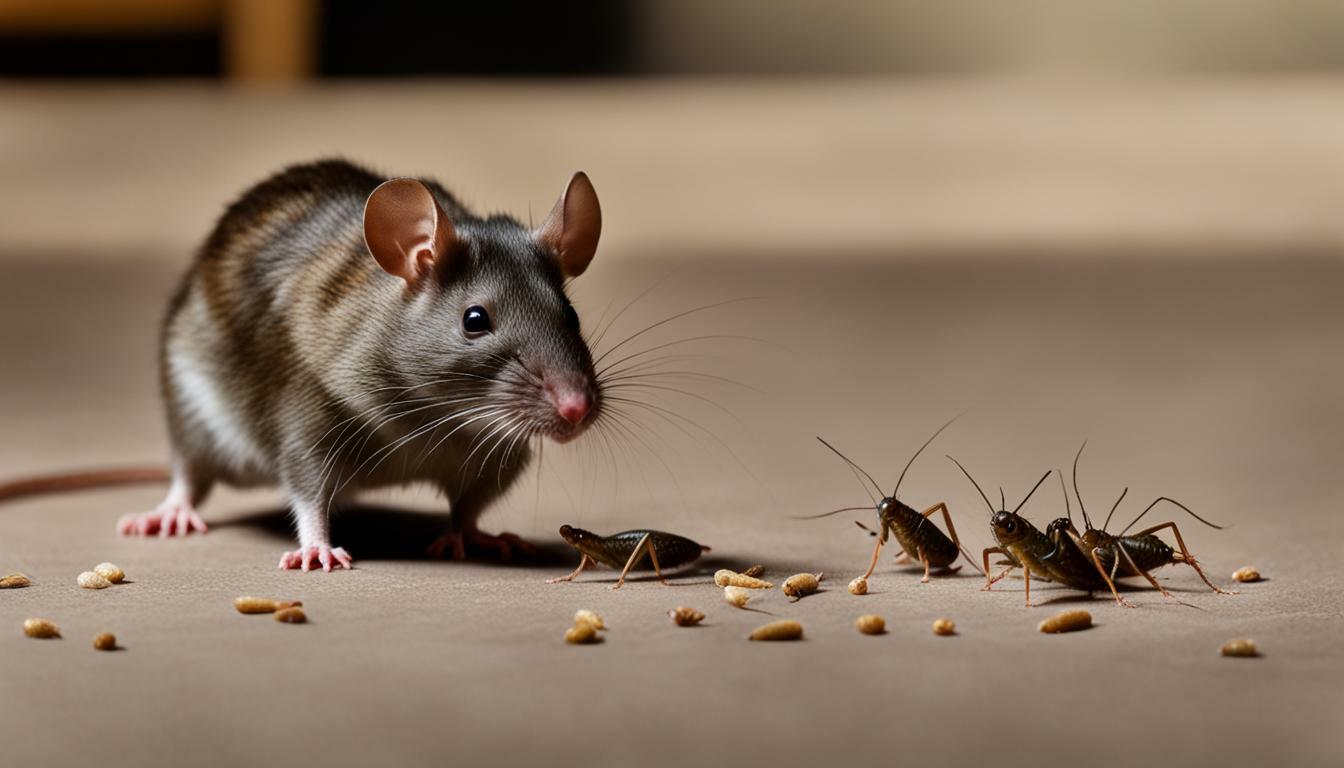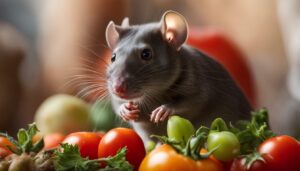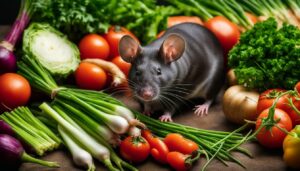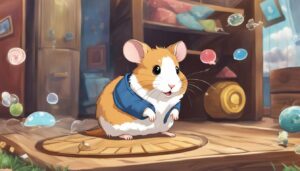If you’re a pet or exotic animal enthusiast, you may be wondering: can rats eat crickets? Rats can indeed consume crickets, but it’s important to understand their dietary needs and considerations. While crickets can be a beneficial addition to a rat’s diet, they should be fed in moderation and alongside a varied and balanced food plan that includes fruits, vegetables, fiber, and protein.
Key Takeaways:
- Rats can eat crickets as a treat due to their high fat and protein content.
- Crickets are packed with nutrients like calcium, zinc, and magnesium.
- It’s crucial to provide rats with a well-rounded diet that includes a variety of foods.
- Live crickets can be introduced cautiously, as they can be feisty and potentially harm the rat.
- Freeze-dried crickets are a safer alternative to live crickets.
- Regular exercise is essential for maintaining a rat’s overall health and weight.
- Crickets should be fed occasionally, not as a main source of food.
The Benefits of Crickets for Rats
Including crickets in a rat’s diet can provide them with essential nutrients and contribute to their overall nutrition. These small insects are packed with valuable components that support a rat’s health. Crickets are rich in fat and protein, which are essential for a rat’s growth, energy, and muscle development. They also contain a variety of vitamins and minerals, including calcium, zinc, and magnesium.
The high fat content in crickets can be beneficial for rats, especially for those who need to gain weight or require extra calories. Additionally, the protein found in crickets helps to maintain the proper function of a rat’s body, supporting tissue repair and growth. This makes crickets a valuable addition to a rat’s diet, particularly for those who may have dietary restrictions or need additional sources of nutrition.
When introducing crickets to a rat’s diet, it is important to ensure that their overall dietary needs are met. Rats should be provided with a varied and balanced diet that includes fruits, vegetables, fiber, and other sources of protein alongside crickets. This variety is necessary to ensure rats receive all the necessary nutrients for optimal health.
While both live and dried crickets can be fed to rats, caution should be taken when introducing live crickets. Live crickets can sometimes be feisty and may harm the rat. If live crickets are not preferred, freeze-dried crickets can be a suitable alternative. However, it is important to monitor the rat’s weight as crickets are high in fat. Regular exercise should also be provided to maintain the rat’s overall health and weight.
| Nutrient | Amount per 100g of Crickets |
|---|---|
| Protein | 19.1g |
| Fat | 13.7g |
| Calcium | 75mg |
| Zinc | 2mg |
| Magnesium | 36mg |
“Including crickets in a rat’s diet can provide them with a source of essential nutrients and contribute to their overall health and well-being.” – Rat Nutrition Expert
The Nutritional Value of Crickets
Crickets are packed with nutrients like calcium, zinc, and magnesium, making them a valuable addition to a rat’s diet. These tiny insects are not only a great source of protein and fats but also provide essential vitamins and minerals that play a crucial role in maintaining a rat’s overall health.
According to research, crickets contain significantly higher levels of calcium compared to other commonly available feeder insects. Calcium is essential for rats as it helps in the development and maintenance of strong bones and teeth. Zinc, another important mineral found in crickets, supports immune function and growth, while magnesium contributes to nerve and muscle function.
To ensure a well-rounded diet, it is important to feed rats a variety of foods, including fruits, vegetables, fiber, and protein along with crickets. This will provide them with the necessary nutrients and promote their overall well-being. Remember, crickets should be offered as a treat rather than a main food source, as they are high in fat.
| Nutrient | Amount per 100g of Crickets |
|---|---|
| Protein | 21g |
| Fat | 6g |
| Calcium | 75mg |
| Zinc | 2.2mg |
| Magnesium | 37mg |
When introducing live crickets to a rat’s diet, caution should be taken as they can be feisty and may harm the rat. If live crickets are not preferred, freeze-dried crickets can be a suitable alternative. However, it is important to monitor the rat’s weight and provide regular exercise to prevent obesity. Feeding rats crickets should be done occasionally, as a treat, and should not replace their primary source of nutrition.
Feeding Live Crickets to Rats
While rats can eat live crickets, it’s important to exercise caution as live crickets can be feisty and potentially harm the rat. Before introducing live crickets into your rat’s diet, make sure to consider the size of the cricket in relation to your rat’s size. Larger crickets may pose a choking hazard, especially for smaller rats.
When feeding live crickets to your rat, it’s best to supervise the feeding to ensure the safety of your pet. Some rats may become overexcited and aggressive when given live prey, so it’s important to be present and ready to intervene if necessary. Additionally, make sure the crickets are from a trusted source and have not been exposed to any toxic substances or pesticides.
If you’re concerned about the potential risks associated with live crickets, an alternative option is to feed your rat freeze-dried crickets. These can be incorporated into their diet without the need to worry about aggression or harm from live crickets. Freeze-dried crickets provide similar nutritional benefits without the extra challenge of managing live prey.
| Considerations for Feeding Crickets to Rats | |
|---|---|
| Feeding Method | Supervise feeding to ensure safety and prevent overexcitement |
| Cricket Size | Choose an appropriate size to prevent choking hazards |
| Source of Crickets | Ensure crickets are from a trusted source and free from toxins |
| Alternative Option | Consider freeze-dried crickets as a safer alternative to live crickets |
It’s important to remember that while crickets can be a healthy treat for rats, they should not be the main source of food. Rats require a varied diet that includes fruits, vegetables, fiber, and protein in addition to crickets. To maintain a balanced diet, it’s recommended to feed crickets to rats occasionally, as a treat rather than a primary food source.
Monitoring your rat’s weight is crucial when incorporating crickets into their diet, as crickets are high in fat. Regular exercise should be provided to ensure your rat stays fit and healthy. By following these guidelines and providing a well-rounded diet, you can safely incorporate crickets as a treat for your rat without compromising their overall health and well-being.
Alternatives to Live Crickets – Freeze-Dried Crickets
If you’re not comfortable feeding your rat live crickets, freeze-dried crickets can be a suitable alternative. Freeze-dried crickets offer convenience and ease of storage, without compromising on the nutritional value.
Freeze-dried crickets retain many of the nutrients found in live crickets, including protein, fats, and vitamins. They are also a great source of calcium, which is essential for maintaining strong bones in rats. Additionally, freeze-dried crickets are low in moisture, making them a long-lasting option for your pet’s diet.
One of the benefits of freeze-dried crickets is that they eliminate the need to deal with live insects, which can be a hassle for some rat owners. When feeding freeze-dried crickets, remember to rehydrate them before offering them to your rat. This can be done by soaking them in water for a few minutes. This ensures that your rat can easily consume the crickets and benefit from their nutritional content.
| Nutrient | Quantity per 100g of Freeze-Dried Crickets |
|---|---|
| Protein | 60g |
| Fat | 11g |
| Calcium | 1000mg |
| Vitamin A | 200IU |
Remember, regardless of whether you choose live or freeze-dried crickets, it’s important to offer them as occasional treats rather than as a primary food source. Rats have diverse dietary requirements, and their diet should consist of a variety of fruits, vegetables, fiber, and protein sources to ensure overall nutrition and health.
Rat’s Dietary Requirements
Alongside crickets, rats require a well-rounded diet that includes fruits, vegetables, fiber, and protein to meet their nutritional needs. Incorporating these various food groups into a rat’s diet helps ensure they receive the essential vitamins, minerals, and nutrients required for optimal health and wellbeing.
When it comes to fruits, rats can enjoy a range of options such as apples, bananas, berries, and melons. These provide natural sugars, antioxidants, and fiber, supporting their digestive system and overall immune function.
Vegetables are another crucial component of a rat’s diet. Leafy greens like spinach and kale offer essential vitamins and calcium, while carrots, bell peppers, and broccoli provide a variety of nutrients and antioxidants. It’s important to note that vegetables should be introduced gradually to avoid digestive upset.
| Fruits | Vegetables | Protein | Fiber |
|---|---|---|---|
| Apples | Spinach | Chicken | Oats |
| Bananas | Kale | Eggs | Barley |
| Berries | Carrots | Tofu | Brown rice |
| Melons | Bell peppers | Beans | Lentils |
Fiber is essential for the digestive health of rats. It helps prevent constipation and promotes regular bowel movements. Good sources of fiber for rats include oats, barley, brown rice, and lentils. These options are also rich in carbohydrates, which provide energy to support their active lifestyle.
Lastly, rats need protein for proper growth, muscle development, and tissue repair. High-quality protein sources for rats include chicken, eggs, tofu, and beans. Protein is crucial for maintaining their overall health and enhancing their immune system.
Remember, while crickets can be a tasty treat for rats, they should not be the sole focus of their diet. Variety and balance are key to meeting a rat’s nutritional requirements. By providing a diverse range of fruits, vegetables, fiber, and protein, rat owners can ensure their furry friends receive a well-rounded diet and optimal nutrition for a happy and healthy life.
Moderation and Rat’s Weight
While crickets can be a healthy addition to a rat’s diet, it’s crucial to feed them in moderation due to their high fat content. Rats have specific dietary requirements that need to be met for optimal health, and an excessive intake of crickets can lead to weight gain and associated health issues.
It’s important to remember that rats are omnivorous and require a balanced diet that includes a variety of foods. While crickets are high in fat and protein, which are beneficial for rats, they should be offered as an occasional treat rather than a main source of food.
Feeding rats crickets should be done in moderation, taking into account their individual nutritional needs and overall calorie intake. A good rule of thumb is to offer crickets as a supplement to their regular diet, ensuring that the majority of their food comes from a balanced mixture of fruits, vegetables, fiber, and other sources of protein.
| Feeding Recommendations: |
|---|
| Offer crickets as a treat, not as a main food source |
| Monitor the rat’s weight regularly |
| Provide regular exercise opportunities |
Rats should have access to a wheel or other forms of exercise to maintain their overall health and weight. An active lifestyle can help counterbalance the additional calories from the crickets and prevent weight gain.
In summary, while rats can enjoy the occasional cricket as a treat, it’s crucial to practice moderation and ensure they receive a well-balanced diet. By offering crickets in the right amounts and providing your rat with plenty of exercise, you can help maintain their weight and overall health.
Exercise for Rats
In addition to a balanced diet, rats require ample exercise to stay fit and maintain a healthy weight. Regular physical activity is essential for their overall well-being as it helps prevent obesity and promotes cardiovascular health. Rats are naturally active creatures, and they need an outlet for their energy to prevent boredom and behavioral issues.
Rat owners can provide various forms of exercise to keep their furry friends active and engaged. One option is to provide a spacious and stimulating environment for rats to explore. A large cage with multiple levels, tunnels, and hiding spots can encourage natural behaviors like climbing and burrowing. Adding platforms, ramps, and toys can also stimulate their curiosity and encourage movement.
Furthermore, allowing rats to roam in a supervised and rat-proofed area outside their cage can provide additional exercise. Rat-proofing involves removing hazards and blocking off access to potential dangers, such as electrical cords, toxic plants, and small openings where rats could escape. This supervised free-roaming time allows rats to stretch their legs, interact with their environment, and provide mental stimulation.
Additionally, interactive playtime with their owners can be an excellent source of exercise for rats. Activities such as gentle wrestling, chasing a toy, or teaching them tricks can help strengthen the bond between the rat and its owner while providing physical exercise. However, it is crucial to handle rats with care and ensure that playtime is a positive and enjoyable experience for both the owner and the pet.
Exercise Tips for Rats:
- Provide a spacious cage with multiple levels and stimulating toys
- Supervise and rat-proof an area outside the cage for additional exercise
- Engage in interactive playtime with your rat
- Rotate toys and provide new challenges to keep them engaged
- Keep an eye on their activity level and adjust exercise routines accordingly
| Activity | Benefits |
|---|---|
| Rat-proofed Exploration Area | Encourages natural behaviors, provides mental stimulation, and prevents boredom |
| Interactive Play | Strengthens the bond between the owner and rat, provides physical exercise, and stimulates cognitive abilities |
| Spacious Cage with Toys | Allows for climbing and exploration, prevents obesity, and promotes overall well-being |
Frequency of Feeding Crickets to Rats
Feeding crickets to rats should be done occasionally, as a treat, rather than as a primary source of food. While crickets offer nutritional benefits, it is important to consider the overall dietary needs of rats. A balanced rat diet should consist of a variety of fruits, vegetables, fiber, and protein, with crickets serving as a supplement rather than the main course.
“Moderation is key when it comes to incorporating crickets into a rat’s diet,” advises Dr. Emily Thompson, a veterinarian specialized in small animal nutrition.
“Rats have specific dietary requirements, and relying solely on crickets may lead to imbalances in their nutrition. It’s essential to provide a combination of nutrient-rich foods to promote optimal health and prevent deficiencies.”
To help maintain a healthy weight, it is recommended to monitor your rat’s food intake and provide regular physical activity. Dr. Thompson adds,
“Rats, like humans, can easily become overweight if they consume excessive amounts of high-fat foods. Engaging in playtime and providing opportunities for exercise not only supports their physical health but also stimulates their mental well-being.”
| Feeding Guidelines for Crickets | Frequency |
|---|---|
| Rat Weight: Less Than 250g | 1-2 crickets per week |
| Rat Weight: 250g-500g | 2-3 crickets per week |
| Rat Weight: Over 500g | 3-4 crickets per week |
“It’s important to note that these feeding guidelines should be adjusted based on your individual rat’s activity level, age, and overall health,” cautions Dr. Thompson.
- Always introduce new foods gradually, including crickets, to prevent digestive upset.
- If you choose to feed live crickets, supervise the interaction closely to ensure the safety of your rat.
- If you opt for freeze-dried crickets, make sure to offer them as a supplement alongside a well-rounded diet.
By incorporating crickets into a rat’s diet in moderation, owners can provide their furry companions with variety and additional nutrients while maintaining their overall health and well-being.
Conclusion
In conclusion, rats can safely eat crickets as a treat, but it’s crucial to prioritize a varied and balanced diet that includes other essential nutrients for their overall well-being. Crickets are high in fat and protein, which can be beneficial for rats, but they should not be the sole source of nutrition.
When incorporating crickets into a rat’s diet, it’s important to also provide fruits, vegetables, fiber, and other sources of protein. These additional food items will ensure that rats receive a well-rounded diet that meets all of their nutritional needs.
Rats can consume both live and dried crickets, but caution should be taken when introducing live crickets. Live crickets can be feisty and may potentially harm the rat. If live crickets are not preferred, freeze-dried crickets can be a suitable alternative. However, it’s crucial to monitor the rat’s weight due to the high fat content of crickets, and regular exercise should be provided to maintain their overall health and weight.
Feeding rats crickets should be done occasionally, as a treat, rather than relying on them as a primary food source. This will help prevent any potential imbalances in their diet. Remember to prioritize a varied and balanced diet that caters to all of a rat’s nutritional requirements, ensuring their long-term health and well-being.
FAQ
Can rats eat crickets?
Yes, rats can eat crickets as a treat. Crickets are high in fat and protein, which are beneficial for rats. However, it is important to feed them a varied and balanced diet that includes fruits, vegetables, fiber, and protein along with crickets. Crickets should not be the main source of food.
What are the benefits of crickets for rats?
Crickets are packed with nutrients like calcium, zinc, and magnesium, which can support a rat’s health. They provide a high-fat and high-protein treat for rats.
Can rats eat live crickets?
Rats can eat both live and dried crickets, but caution should be taken when introducing live crickets. Live crickets can be feisty and may harm the rat. If live crickets are not preferred, freeze-dried crickets can be introduced to the rat’s diet.
What are the alternatives to live crickets?
Freeze-dried crickets can be an alternative for rat owners who prefer not to feed live crickets. They provide similar nutritional benefits without the concerns of live crickets.
What are the dietary requirements for rats?
Rats require a varied and balanced diet that includes fruits, vegetables, fiber, and protein. While crickets can be included, they should not be the main source of food.
Should rats be monitored for weight when fed crickets?
Yes, crickets are high in fat, so it is crucial to monitor the rat’s weight. Regular exercise should be provided to maintain their overall health.
How frequently should rats be fed crickets?
Feeding rats crickets should be done occasionally, as a treat, rather than a regular part of their diet. It is important to treat them as occasional treats rather than a main food source.




